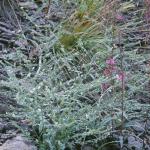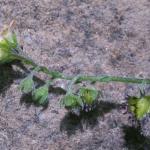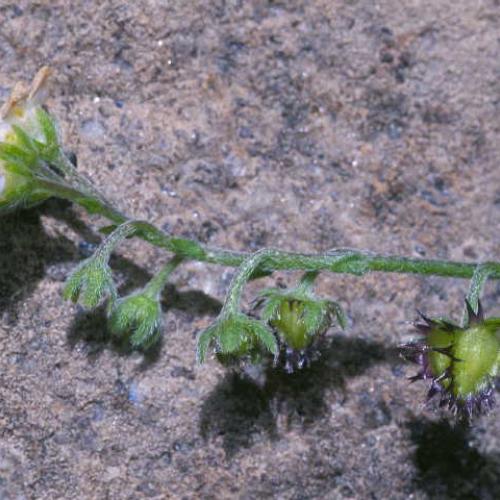Description
Biennial herb; stems one or a few, 2-6 dm tall, covered with appressed and somewhat spreading hairs; leaves hairy, those at base of plant oblanceolate, withering early, 2-7 cm long, stem leaves lanceolate or oblong 3-10 cm long; inflorescence a coiled cyme in flower, then much elongating in fruit, fruiting flowers nodding downward, most flowers subtended by small leaf-like bracts 3-10 mm long; flower petals united into a short tube and spreading 5-lobed limb; corolla 4-8 mm in diameter, blue on limb and white in center, throat of corolla tube with 5 minutely hairy appendages (fornices); nutlets usually 4 per flower (sometimes fewer by abortion), nutlet margins armed with a single row of prickles with small branching hooks at the tips, dorsal surfaces of nutlets papillate,without additional prickles. Flowers July and August.
Similar Species
Differs from the annual Lappula redowskii by its biennial habitat and nodding fruits. Hackelia besseyi is also very hairy, but is a slender plant with flowers that are only 1 or 2 mm in diameter and only a few inflorescence bracts at the bases of the cymes. Hackelia floribunda is less hairy and has shorter, naked cymes (no bracts).
Distribution
New Mexico, Colfax, Mora, Rio Arriba, Sandoval, San Miguel, Santa Fe, Taos, and Union counties, Jemez Mountains, Canjilon Mountains, southern Sangre de Cristo Mountains, and Capulin Volcano.
Habitat
Dry sites of shaley or igneous soils in lower to upper montane coniferous forest, usually with Gambel oak; 2,350-3,100 m (7,700-10,200 ft).
Conservation Considerations
Distribution is sporadic and local populations are not large. The species often occupies roadcuts or excavations that expose mineral soils. It is not significantly threatened by common land uses within its habitats.
Important Literature
Gentry, J.L. and R.L. Carr. 1974. A revision of the genus Hackelia (Boraginaceae) in North America north of Mexico. Memoirs of the New York Botanical Garden 26(1):121-227.
Wooton, E.O. and P.C. Standley. 1913. Descriptions of new plants preliminary to a report upon the flora of New Mexico. Contributions from the U.S. National Herbarium 16:109-196.
Higgins, L.C. 1979. Boraginaceae of the southwestern United States. Great Basin Naturalist 39(4):293-350.






